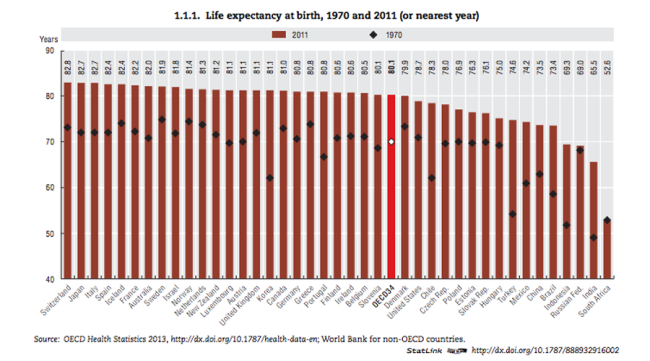
Although Americans are living longer, they aren’t living as long as people in other countries.
Life expectancy has increased immensely in many nations, yet the United States seems to be lagging behind, according to a 2011 report from the National Academy of Sciences Organization for Economic Cooperation and Development.
According to a 2006 report from the National Academy of Sciences, American longevity has dropped by a significant amount since 1979 when compared to the longevity in other places around the world.
Australian and Japanese men live up to an average of 78 years old where as American men only live to an average of 75.
The most considerable shift is among the longevity of women. Going from being the longest living women in the 1960s at an average of 86 years old, American women are now listed as 28th with an average of 80 years old.
Between 1980 and 2006, Japanese women were able to reach an average of 86 years, followed closely by the Italians and the French women who live up to an average of 84 years.
No particular reason can be pinpointed as the cause behind the drop in life expectancy according to a 2011 report from the National Institutes for Health. One clue as to this change, pointed out by researchers, is that Americans seem to have the highest vulnerability between the ages of 55 and 75.
Between those ages is when many Americans commonly die from heart disease, diabetes and lung disease at a higher rate than those living in other countries. If an American can live past the age of 75, they have a greater chance at living a long life as well as adding to the increasing numbers living well into their 90s and even 100s.
Nancy Churnin of The Dallas Morning News reported that local experts say people are especially vulnerable from ages 55 to 75 because this is when people typically experience the cumulative effects of poor nutrition and lack of exercise and lack of screenings converging at the same time.
Unhealthy lifestyle choices can lead to clogged arteries, high blood pressure, insulin resistance and cancer being spotted too late for effective treatment.
As far as Dr. Diana Kerwin, chief of geriatrics at Texas Health Dallas, is concerned, obesity is the No. 1 reason behind poor health. Krewin also blames American’s sedentary lifestyle for increasing fatal diseases.
Heart disease remains the leading cause of death for both men and women in the United States. According to a 2006 report from the Centers for Disease Control and Prevention, heart disease kills one in four Americans.
Another contributing factor effecting women’s health is the lack of awareness of the symptoms of heart attacks in females, which can result in critical lapses of time before women seek life-saving care.
Smoking cigarettes can also increase chances of disease as well as complicate already existing health problems. Although in 2012, the percentage of American that smoke has dropped from 18.9 percent to 18 percent according to the National Center for Health Statistics.
Dr. Mitchell Magee, medical director of CLEAR (Chest Lung Evaluation and Resource) Clinic and surgical director of thoracic oncology at Medical City Dallas, still says that those number are still too high.
Many Americans don’t realize that they are still at risk of getting lung cancer even if they don’t smoke, Magee said.
Women seem to be at a higher risk of this disease. The rate of new lung cancer cases has dropped 22 percent for men over the past 33 years, it has risen by 106 percent in women, according to the American Cancer Society.
Out of any other type of cancer, lung cancer has the highest mortality rate. Lung cancer causes more deaths in women than breast, uterine and ovarian cancer combined.
Magee also attributes part of the problem to a lack of research and screenings for lung cancer. By the time symptoms appear, it usually is too late to save the patient’s life.
Despite this news, this information doesn’t mean American’s decline in longevity is inevitable or unsolvable.
Emotional and psychological needs are also a huge part of the health and longevity picture. Many Americans’ health is effected by the high amounts of stress dealt with on the daily basis. Engaging in stress-relieving activities could not only help Americans relax, but could also extend life expectancy.
Exercise is important in increasing the odds for living a longer life. According to the Centers for Disease Control and Prevention, 150 minutes of exercise per week is optimal.
Eating right is also a huge player in one’s health. Avoiding processed foods, limiting sodium intake and alcohol, drinking four to six cups of water daily and eliminating liquid sugars can do wonders for anyone’s health.
For smokers, one of the best things that can be done for their health is to quit. Tobacco smoke causes several kinds of cancers for smokers and non-smokers that are exposed to second-hand smoke.
Getting screened and going in for check-ups with a doctor is also an important aspect of being healthy. Asking a doctor for updates by doing important screenings relative to a patient’s age, condition and genetic risk factors can help catch disease in the early stages.
Making sure to enjoy life will also benefit health and help people live longer. There is a very apparent link between happiness and health according to a 2011 article from the Harvard School of Public Health. Anger and anxiety can disrupt cardiac function and harm the brain. On the other hand, enthusiasm, hopefulness and laughing can actually reduce illness as well as ward off certain diseases.













